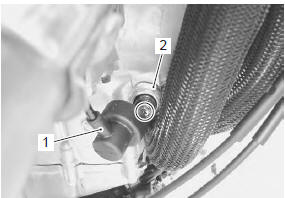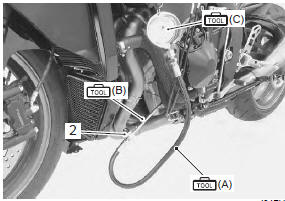Suzuki GSX-R 1000 Service Manual: Diagnostic information and procedures
Engine lubrication symptom diagnosis

Oil pressure check
Check the engine oil pressure periodically. This will give a good indication of the condition of the moving parts.
| Note before checking the oil pressure, check the following.
|
- Start the engine and check if the oil pressure indicator light is turned on. If the light stays on, check the oil pressure indicator light circuit. If the circuit is ok, check the oil pressure in the following manner.
- Remove the left side cowling. Refer to “exterior parts removal and installation” in section 9d .
- Remove the oil pressure switch lead wire (1) and oil pressure switch (2).

- Install the special tools to the mounting hole of the oil pressure switch.
Special tool (a): 09915–74521 (adapter hose) (b): 09915–17410 (oil pressure gauge adapter) (c): 09915–77331 (oil pressure gauge (1000 kpa))
- Install the oil pressure switch (2) to the adapter.

- Warm up the engine as follows: summer: 10 min. At 2 000 r/min winter: 20 min. At 2 000 r/min
- after warming up, increase the engine speed to 3
000 r/min (observe the tachometer), and read the oil
pressure gauge.
If the oil pressure is lower or higher than the specification, the following causes may be considered.
Oil pressure specification 100 – 400 kpa (1.0 – 4.0 Kgf/cm2, 14 – 57 psi) at 3 000 r/min, oil temp. 60 °C (140 °f)
|
High oil pressure |
Low oil pressure |
|
|
- Stop the engine and remove the oil pressure gauge and attachment.
- Reinstall the oil pressure switch. Refer to “oil pressure switch removal and installation” .
- Check the engine oil level. Refer to “engine oil and filter replacement” in section 0b .
- Install the left side cowling. Refer to “exterior parts removal and installation” in section 9d (page 9d- 6).
 Schematic and routing diagram
Schematic and routing diagram
Engine lubrication system chart diagram
Engine lubrication circuit diagram
...
 Repair instructions
Repair instructions
Engine oil and filter replacement
Refer to “engine oil and filter replacement” in section 0b .
Engine oil level inspection
Refer to “engine oil and filter replacement” in section 0b . ...
Other materials:
Special tools and equipment
Recommended service material
Note
required service material is also described in the following.
“Exhaust system components”
Special tool
...
Wiring harness routing diagram
Wiring harness no. 2
Tapping clamp
: insert the clamp from the front side. Place the turn signal
and position light couplers in front of the clamp.
Steel clamp
: clamp the wiring harness at the blue taping point. Bend
the steel clamps to the front side.
...
Oil pressure indicator inspection
Inspect the oil pressure indicator in the following
procedures:
Note
before inspecting the oil pressure switch, check if the engine oil level
is correct. Refer to “engine oil and filter replacement” in section 0b .
Remove the left side cowling. Refer to “exterior parts remov ...
